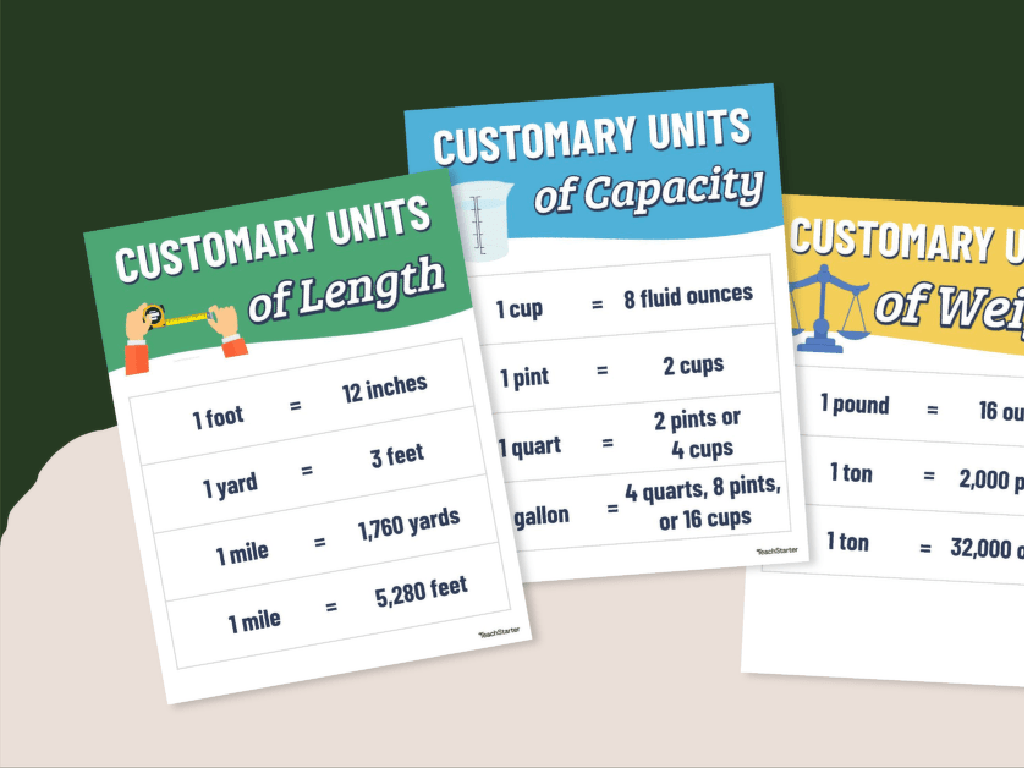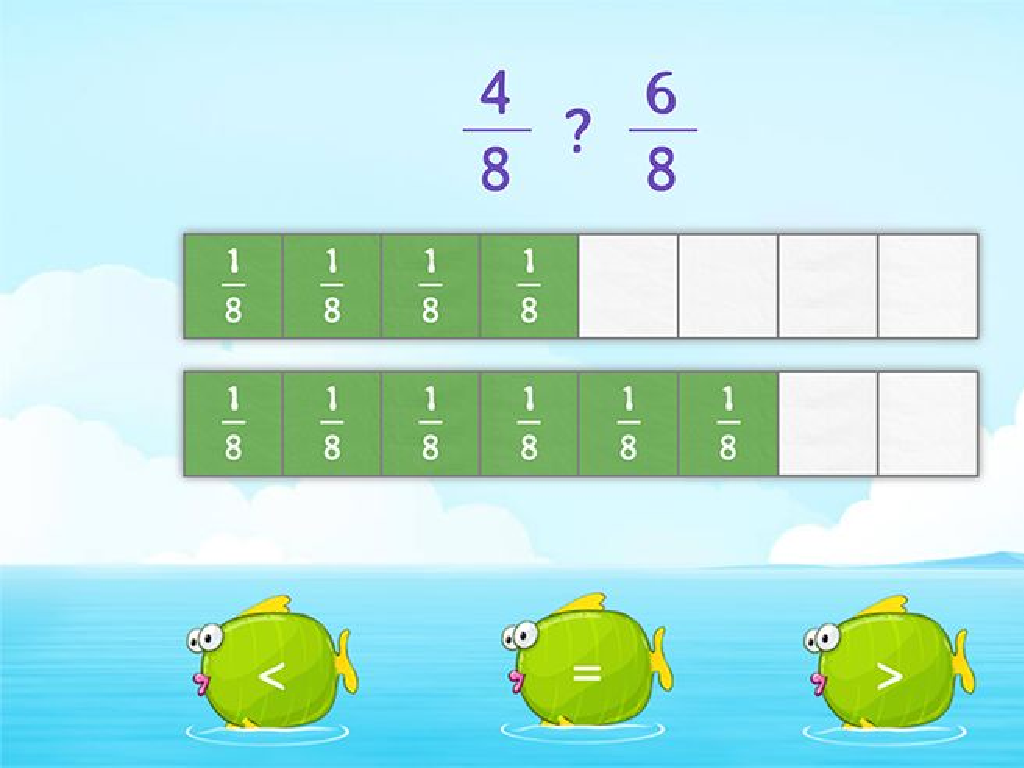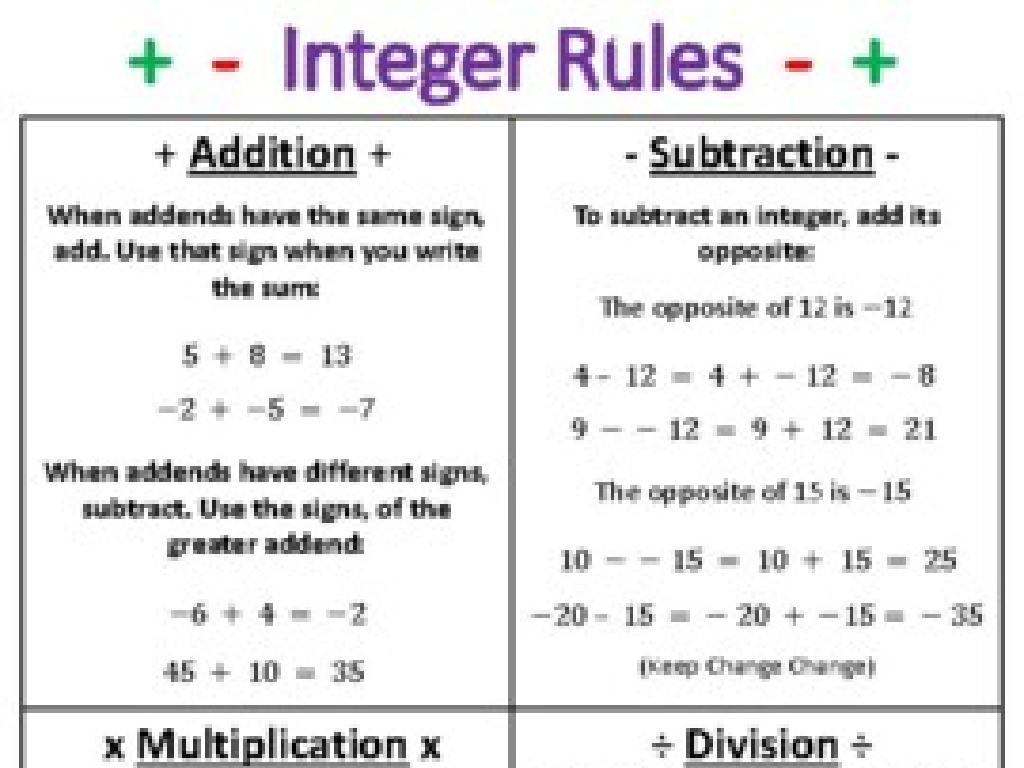Plant Cell Diagrams: Label Parts
Subject: Science
Grade: Fourth grade
Topic: Cells
Please LOG IN to download the presentation. Access is available to registered users only.
View More Content
Exploring Plant Cells: The Building Blocks of Life
– Discover the world of cells
– Today’s focus: Plant cells
– Plant cells have unique parts like chloroplasts for photosynthesis
– Cells as life’s foundation
– All living things are made up of cells, the basic unit of life
– Key components of cells
– Cell wall, nucleus, cytoplasm, and more
|
This slide introduces the concept of cells as the fundamental units of life, with a specific focus on plant cells. It’s crucial to explain that while all living organisms are composed of cells, plant cells have unique structures that differentiate them from animal cells, such as the presence of a cell wall and chloroplasts. Emphasize the importance of each part of the cell and its role in the life of the plant. Use diagrams to visually represent the cell and its components. Encourage students to think about the function of each part as they prepare to learn how to label a plant cell diagram. This foundational knowledge sets the stage for understanding more complex biological processes.
Exploring Plant Cells
– What is a plant cell?
– The basic building block of plant life, enclosed by a cell wall.
– Plant vs. animal cells
– Plant cells have a cell wall and chloroplasts, unlike animal cells.
– Plant cells’ role in nature
– They make their own food, provide oxygen, and form the basis of the ecosystem.
|
This slide introduces students to the concept of plant cells, highlighting their definition, unique characteristics compared to animal cells, and their importance in nature. Emphasize that plant cells are the fundamental units of plants, with a rigid cell wall that provides structure. Discuss how chloroplasts allow plants to photosynthesize, a process not found in animal cells. Explain the role of plant cells in producing oxygen and food, which are essential for life on Earth. Use diagrams to visually represent the differences between plant and animal cells and to illustrate how plant cells work within the ecosystem. Encourage students to think about how plants are involved in their daily lives and the environment.
Exploring Plant Cell Parts
– Cell Wall: The Strong Protector
– Surrounds the cell, giving it shape and protection.
– Cell Membrane: The Gatekeeper
– Controls what goes in and out, like a gate.
– Cytoplasm: The Cell’s Playground
– Jelly-like substance where organelles float.
|
This slide introduces students to the basic parts of a plant cell and their functions. The cell wall is a rigid layer that supports and protects the cell. The cell membrane is a selective barrier that regulates the movement of substances into and out of the cell. The cytoplasm is a gel-like substance inside the cell where various organelles are located, each with its own function. Use diagrams to help students visualize these parts. Encourage them to think of the cell wall as a fortress, the membrane as a security gate, and the cytoplasm as a playground where all the cell’s activities happen. This analogy will help them remember the functions of each part.
The Powerhouse and Food Factory of Plant Cells
– Mitochondria: Cell’s Powerhouse
– Converts nutrients into energy
– Chloroplasts: Cell’s Food Factory
– Where photosynthesis happens
– Importance of these organelles
– Essential for energy and food production
|
This slide introduces students to two critical organelles within plant cells: the mitochondria and chloroplasts. Mitochondria are known as the powerhouse of the cell because they convert nutrients from the cell’s environment into usable energy. Chloroplasts are referred to as the food factory of the cell, as they are the site of photosynthesis, where sunlight is converted into chemical energy for the plant. Understanding the functions of these organelles helps students grasp how energy is produced and utilized in plant cells, which is fundamental to their biology studies. Encourage students to think of the cell as a mini-city, with the mitochondria as the power plants and chloroplasts as the food production centers. This analogy can help them remember the roles of each organelle.
The Control Center: Nucleus
– What is the Nucleus?
The nucleus is like the brain of the cell, directing all activities.
– Functions of the Nucleus
It stores our genetic material and instructions for growth.
– DNA: Life’s Blueprint
DNA holds all the plans for how a plant grows and survives.
– Nucleus in Plant Cells
In plant cells, the nucleus also helps in photosynthesis.
|
The nucleus is a vital organelle in plant cells that acts as the control center, managing the cell’s activities. It’s important for students to understand that the nucleus contains DNA, which is like a set of blueprints that guides the growth, development, and functioning of the plant. Functions of the nucleus include storing genetic information, coordinating cell activities like growth and reproduction, and playing a role in the process of photosynthesis. When discussing the nucleus with fourth graders, use analogies they can relate to, such as comparing the nucleus to the principal’s office that oversees a school. Encourage students to ask questions about how the nucleus affects the life of a plant.
Vacuoles: The Storage Bins of Plant Cells
– What are Vacuoles?
– Vacuoles are like storage containers inside cells.
– Vacuoles’ role in plant cells
– They store water, food, or waste for the cell.
– Keeping plants healthy
– They help keep plants rigid and healthy.
|
Vacuoles are essential components of plant cells, acting as storage centers. They can be thought of as large sacs that hold various substances the cell may need to survive or get rid of, such as nutrients, water, or waste products. In plant cells, vacuoles are particularly large and help maintain the structure of the plant by storing water and keeping the cells turgid. This is crucial for the plant’s overall health, as it helps the plant stand upright and retain a healthy appearance. During the presentation, use diagrams to show where vacuoles are located in the cell and discuss how their function contributes to the well-being of the plant. Encourage students to think of vacuoles as the ‘pantry’ of the cell, storing important materials for later use.
Labeling the Plant Cell
– Let’s label cell parts together
– Identify each part on the diagram
– Look at the cell wall, nucleus, chloroplasts, and more
– Understand functions during labeling
– Learn what each part does as we label
– Discuss the role of each part
– Why is the nucleus important? What does the chloroplast do?
|
This slide is designed to be interactive, guiding students through the process of labeling a plant cell diagram. Start by introducing the cell and its importance to plant life. As you label each part, such as the cell wall, nucleus, and chloroplasts, explain their functions. For example, the cell wall provides structure, the nucleus is the control center, and chloroplasts are where photosynthesis happens. Encourage students to ask questions and discuss the role of each part. This will help them understand not just the names of cell parts, but also their purpose in the life of a plant.
Class Activity: Create Your Own Plant Cell
– Gather Play-Doh, labels, and diagram sheet
– Model the plant cell using Play-Doh
– Use different colors for various cell parts like nucleus, chloroplasts
– Label each part on your cell model
– Ensure labels are clear: cell wall, cell membrane, nucleus, etc.
– Review the functions of each part
– Discuss with classmates and compare your models
|
This hands-on activity is designed to help students learn about plant cell structures by creating a 3D model. Provide each student with Play-Doh, a set of labels, and a diagram sheet that outlines the parts of a plant cell. Students will use Play-Doh to construct the cell, then use the labels to identify each part, such as the cell wall, cell membrane, nucleus, chloroplasts, and vacuoles. Encourage creativity in using different colors to represent different parts. After modeling, students should review the function of each cell part with their peers. Possible variations of the activity could include using different materials for modeling, drawing the cell parts instead of modeling, or presenting their model to the class explaining the function of each part.
Review: Parts of the Plant Cell
– Recap of today’s lesson
– Naming plant cell parts
– Can you recall the nucleus, cell wall, and chloroplasts?
– Engage in Q&A session
– Ask any questions you have about plant cells
– Reflect on what we’ve learned
– Think about how each part functions
|
This slide is aimed at reviewing the key concepts from today’s lesson on plant cell diagrams. Start by summarizing the lesson, highlighting the main parts of the plant cell such as the nucleus, cell wall, chloroplasts, and mitochondria. Encourage the students to name the parts of the plant cell from memory, which will help reinforce their learning. Open the floor for a question and answer session, allowing students to clarify any doubts and solidify their understanding. Conclude by asking students to reflect on the function of each part of the plant cell and how they work together to keep the plant alive and healthy. This reflection helps students connect the information to a bigger picture of plant biology.
Homework: Exploring Plant Cells
– Take home a labeling worksheet
– Draw a plant cell from memory
– Practice sketching the cell structure
– Label each part of the plant cell
– Include the nucleus, cell wall, chloroplasts, etc.
– Discuss your learning with family
– Explain the function of each part you label
|
This homework assignment is designed to reinforce the students’ understanding of plant cell anatomy through active engagement. The worksheet provides a guided activity for labeling the various parts of a plant cell, which helps in memorizing their names and locations. Encouraging students to draw a plant cell from memory will aid in retention and understanding of the cell’s structure. Labeling each part ensures they can identify and understand the role of each component. Finally, discussing their findings with family members allows students to articulate their knowledge, further solidifying their learning. This activity also bridges school learning with home life, fostering an environment where education is a shared experience.






